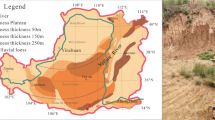Abstract
Field texture is of essential importance in the development of the mud vegetation of dwarf-plants. Soil consisting of a high proportion of small primary particles is able to store appropriate quantities of water, and transfers water to the plants with difficulty. Thus, the species which have adapted to these conditions have a competitive advantage over concurrent ones. The clay-rich soil hinders the availability of nitrogen. Hence, nitrophilous vegetation does not develop here. Due to the high adsorption capacity of the soil it may contain a large amount of available phosporus and potassium.
The low osmotic activity of the soil is favourable for the development of the mud vegetation of dwarf-plants with a high cover degree.
Similar content being viewed by others
Literature Cited
Ant H. etDiekjobst H. (1967): Zum räumlichen und zeitlichen Gefüge der Vegetation trockengefallener Talsperrenböden.—Arch. Hydrobiol., Stuttgart, 62: 439–452.
Bagi I. (1987): Studies on the vegetation dynamics ofNanocyperion communities III. Zonation and succession.— Tiscia, Szeged, 22: 31–45.
Bagi I. (1988): Effects of mud vegetation on the nutrient condition of flood-plain lakes.—Aquatic Bot., Amsterdam, 32: 321–328.
Bagi I. etBodrogközy G. (1984): Seasonal dynamics of the succession series at the Körös flood-plain leading to the association of theEchinochloo-Heleochloetum alopecuroidis (Rapcs. 27)Bodrk. 82.—Tiscia, Szeged, 19: 113–135.
Braun-Blanquet J. etMoor M. (1935): Über dasNanocyperion in Graubünden und Oberitalien.— Jahresber. Naturforsch. Ges. Graubünden, Chur, 73: 25–35.
Burrichter E. (1960): Die Therophyten Vegetation an nordhein-westfälischen Talsperren in Trockenjahr 1959. —Ber. Deutsch. Bot. Ges., Stuttgart, 73: 24–37.
Dégen I. (1973): The significance of the Kisköre Barrage Project in water management.—In:Ihrig D./red./: The Kisköre Barrage Project, Vízügyi Közlemények, Suppl., Budapest, p. 7–39.
Godshalk G.L. etBarko J.W. (1985): Vegetative succession and decomposition in reservoir.—In:Gunnison D./red./: Microbial processes in reservoirs, W. Junk Publishers, Dordrecht, p. 59–77.
Golterman H.L. (1969): Methods for chemical analysis of fresh waters.—IBP Handbook No 8., Blackwell Scientific Publications, Oxford, 116 p.
Grime J.P. (1979): Plant strategies and vegetation processes.—Chichester, 222 p.
Hejný S. (1960): Ökologische Charakteristik der Wasser- und Sumpfpflanzen in den Slowakischen Tiefebenen (Donau- und Theissgebiet).—Bratislava, 487 p.
Klika J. (1935): Die Pflanzengesellschaften des entblössten Teichbödens in Mitteleuropa.—Beih. Bot. Cbl., Abt. B, Dresden, 53: 286–310.
Koch W. (1934):Cyperus michelianus (L.)Link undLindernia pyxidaria L. am Luganer See bei Agno als Characterarten derEleocharis ovata Assoziation.—Ber. Schweiz. Bot. Ges., Zürich, 43, (2).
Korneck D. (1960): Beobachtungen an Zwergbinsengesellschaften im Jahre 1959.—Beitr. Naturk. Forsch. SW-Deutschl., Karlruhe/Baden, 19: 101–110.
Lohmeyer W. (1953): Über einige Fundorte desEleocharetum ovatae in der Oberfalz.—Mitt. Flor-Soz. Arbeitsgem. N.F., Stolzenau/Weser, 4: 110–111.
Moor M. (1936): Zur Soziologie derIsoetetalia.—Beitr. Geobot. Landesaufnahme Schweiz, Bern, 20: 148 p.
Moor M. (1937): Ordnung derIsoetetalia (Zwergbinsengesellschaften).—Prodromus der Pflanzengesellschafter, Leiden, 4: 24 p.
Moore P.D. etChapman S.B. (1986): Methods in plant ecology. 2nd ed., Blackwell Scientific Publications, Oxford, 589 p.
Müller-Stoll W.R. etPietsch W. (1985): ökologische Untersuchungen über die Gesellschaft desEleocharito- Caricetum bohemicae auf wasserfrei gewordenen Teichböden in Zentraleuropa.—Verh. Zool.-Bot. Ges. Wien, 123: 51–70.
Pietsch W. (1973): Zur Soziologie und Ökologie der Zwergbinsen-Gesellschaften Ungarns (KlasseIsoeto-Nanojuncetea Br.-Bl. etTx. 1943).—Acta Bot. Hung., Budapest, 19: 269–288.
Pietsch W. etMüller-Stoll W.R. (1968): Die Zwergbinsen- Gesellschaft der nackten Teichböden im östlichen Mitteleuropa,Eleocharito-Caricetum bohemicae.—Mitt. Flor.-Soz. Arbeitsgem. N.F., Stolzenau/Weser, 13: 14–47.
Pietsch W. etMüller-Stoll W.R. (1974): Übersicht über die im brandenburgische Gebiet vorkommenden Zwergbinsen- Gesellschaften (Isoeto-Nanojuncetea).—Verh. Bot. Ver. Prov. Brandenburg, 109: 56–95.
Prach K., Květ J. etOstrý J. (1987): Ecological analysis of the vegetation in a summer-drained fishpond.—Folia Geobot. Phytotax., Praha, 22: 43–70.
Runge F. (1960): Die Eisimsen-Teichschlamm-Gesellschaft in sauerlandischen Talsperren.—Arch. Hydrobiol. Stuttgart, 57: 217–222.
Soó R. (1973): Synopsis systematico-geobotanica florae vegetationisque Hungariae V.—Akadémiai Kiadó, Budapest, 724 p.
Tilman D. (1985): The resource-ratio hypothesis of plant succession.—Amer. Nat., 125: 827–852.
Tilman D. (1986): A consumer-resource approach to community structure.—Amer. Zool., 26: 5–22.
Tímár L. (1950): The vegetation of the flood area of River Tisza between Szolnok and Szeged.—Ann. Biol. Univ. Debrecen, 1: 72–145 [in Hungarian]
Uhlig J. (1931): Die Gesellschaft des nackten Teichschlammes.—Ber. Naturw. Ges. Chemnitz, 23: 50–66.
Wetzel R.G. etHough R.A. (1973): Productivity and role of aquatic macrophytes in lakes. An assessment. —Pol. Arch. Hydrobiol., 20: 9–19.
Author information
Authors and Affiliations
Rights and permissions
About this article
Cite this article
Bagi, I. Edaphic factors in the development of dwarf-plant communities of mud. Folia geobot. phytotax. 26, 431–437 (1991). https://doi.org/10.1007/BF02912777
Received:
Accepted:
Issue Date:
DOI: https://doi.org/10.1007/BF02912777




